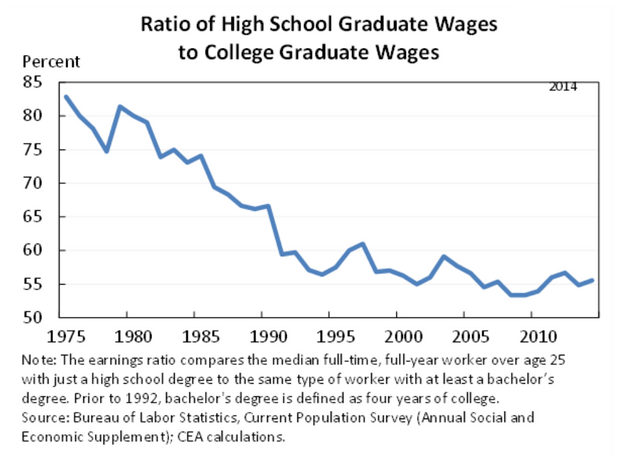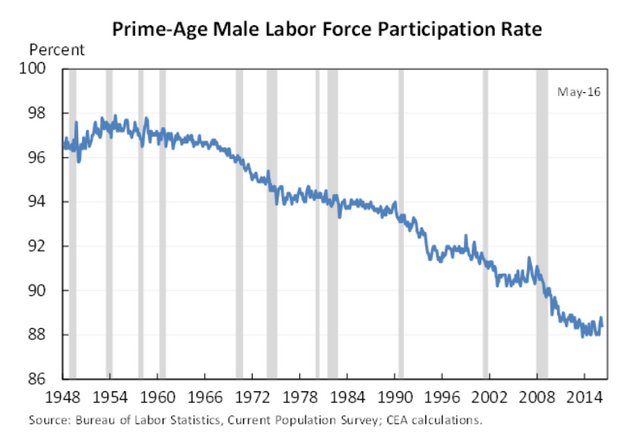Patrick Martin
Two reports issued over the past week document the drastic worsening of the economic position of the American working class, and the consequent rapid rise in economic inequality.
Men with a high school education now make barely 50 percent of the wages of men with a college degree or more, according to data presented Monday by the White House Council of Economic Advisers. This is down from near equality between the college-educated and the non-college-educated 40 years ago (see Chart 1).
The CEA correlated the declining economic position of blue collar workers (using education as a surrogate for occupation) with the plunge in labor force participation rates among men of prime working age, those between 25 and 54 years of age (see Chart 2).
While 98 percent of men of prime working age were in the labor force in 1954, that figure has fallen to 88 percent today (81 percent actually working and 7 percent unemployed but available for work). The same divergence based on education was shown in these figures: 94 percent of male college graduates aged 25 to 54 were in the labor force, but only 83 percent of men with only a high school education.
The proportion of American men not in the labor force has risen six-fold over 60 years, from 2 percent to 12 percent. This compares to 7 percent in Spain and France and only 4 percent in Japan, countries which provide considerably better social benefits for the long-term jobless. In other words, men outside the labor force are both more numerous in the United States, and treated far worse by society.

The CEA report, like most such government and academic studies, is heavily laden with statistical jargon. But one passage makes clear that the brutal wage-cutting and job-slashing directed at workers in manufacturing and other semi-skilled occupations—carried out with the collaboration and support of the unions in those industries that are unionized—is a key factor in this social retrogression.
The report says: “In addition to reducing wages, abrupt demand shifts for less-skilled workers create inconsistencies between workers' expectations of the types of jobs they have traditionally had access to (and that were closely associated with their identity) and the realities of the jobs currently available to less-educated workers—for example, the decline in available jobs in manufacturing. This mismatch between what workers seek and what the job market offers may lead them to leave the labor force …”
In plain English, workers leave the labor force because they can no longer earn a living and support their families, which has a crushing moral and psychological impact in many cases.
The CEA report further finds that “the drop in the labor force participation rate for men over the past several decades may be explained by a decline in job opportunities for middle-skill workers and their reluctance to take jobs in other industries and skill classes.”
Again, in plain English, workers are dropping out of the labor force because they refuse to go from decent-paying factory jobs to low-paying work at WalMart, fast food or other so-called service industries.
Other details in the CEA report document regional differences, with the lowest rates of labor force participation in smaller industrial centers in the Midwest, the mining areas of Appalachia, and in rural, agricultural areas throughout the country—all areas where there has been little economic diversification and which are remote from high-tech centers or the booming financial markets.
The worst impact of the decline in labor force participation and the relative decline in blue-collar wages has been for black men. This is associated not so much with racial discrimination in employment, which is much less overt today than 60 years ago, as with the enormous increase in incarceration rates.
Men in prison are not included in the jobless figures and their appalling conditions are not recorded in reports like that issued by the CEA. But men who have been released from prison are far less likely to find decent-paying work and consequently leave the labor force altogether. These are disproportionately black and Latino.
The second report issued this past week was by the Economic Policy Institute, a liberal think tank supported by the AFL-CIO. This provided a state-by-state picture of the growth of economic inequality over the past century, supplementing reports issued last year on economic inequality at the national level.
The report found that income inequality declined in every state from 1928 until 1979. From 1979 through 2013, by contrast, economic inequality has risen in every state, and in many states it has now reached the level of 1928, the height of the stock market boom before the Great Depression.
Under the Obama administration, economic inequality has grown worse, and the growth is accelerating. In 15 states, the top 1 percent captured all of the income growth between 2009 and 2013. In 10 of these, the top 1 percent captured more than 100 percent of all income growth, with the result that incomes of the bottom 99 percent actually fell.
For the US as a whole, the top 1 percent captured 85.1 percent of all income growth for that five-year period. The average income of the top 1 percent grew 17.4 percent from 2009 to 2013, while the average income of the bottom 99 percent grew only 0.7 percent. The result is that by 2013, the average income of the top 1 percent was 25.3 times the average for the bottom 99 percent.

The EPI profiled the 10 states with the biggest increase in the share of the top 1 pecent from 1979 to 2007. These included: “four states with large financial services sectors (New York, Connecticut, New Jersey, and Illinois), three with large information technology sectors (Massachusetts, California, and Washington), one state with a large energy industry (Wyoming), one with a large gaming industry (Nevada), and Florida, a state in which many wealthy individuals retire.”
The EPI report refers to one particularly revealing episode in the operations of the wealthy parasites who dominate American society: the bipartisan deal in 2012, between Obama and the congressional Republicans, which extended the Bush tax cuts for all but the highest earners. This legislative change touched off a frenzy of “tax planning” (i.e., fraud) by the super-rich, which caused them to reduce their incomes significantly in 2013. This means that the disparities reported by the EPI study are significantly understated, since the wealthy deliberately avoided “earning” income in 2013 to avoid paying taxes.
Taken together, the CEA and EPI reports document a society that is deeply dysfunctional, unjust and unstable. For the workers who produce the wealth of society, wages and participation in the labor force are plunging. For the parasites in the financial aristocracy who owe their vast fortunes to the labor of others, incomes are rising faster than ever.
It is figures like these that underlie the upheavals that have already shaken the US political system in the course of the 2016 election campaign, which has many months to run its course and more shocks to endure. More fundamentally, these figures are infallible indicators that American society faces an eruption of mass struggle, as young people and working people rebel against the destruction of their jobs, living standards and social rights.
No comments:
Post a Comment